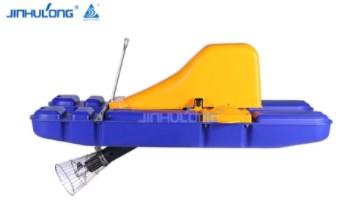In the realm of industrial wastewater treatment, the quest for effective and sustainable solutions is paramount. Deep water jet aerator has emerged as a pivotal technology in this domain, offering a robust approach to the aeration of wastewater. These devices are designed to inject air or oxygen into the depths of water bodies, thereby enhancing the solubility of oxygen and accelerating the biodegradation of pollutants. The application of deep water jet aerators in industrial wastewater treatment has yielded significant results, improving the overall efficiency and effectiveness of the treatment process.
The primary function of deep water jet aerators in industrial wastewater treatment is to facilitate the aerobic decomposition of organic matter. By increasing the dissolved oxygen levels, these aerators create an environment conducive to the growth of aerobic microorganisms, which are instrumental in breaking down complex organic compounds into simpler, less harmful substances. This process not only reduces the biochemical oxygen demand (BOD) and chemical oxygen demand (COD) of the wastewater but also mitigates the release of harmful substances into the environment.
One of the key advantages of deep water jet aerators in industrial wastewater treatment is their ability to operate in deep and large water bodies, where traditional surface aeration methods may be less effective. The high-pressure jets of air or oxygen generated by these devices can penetrate deep into the water column, ensuring uniform distribution of oxygen and promoting a more efficient biodegradation process. This capability is particularly beneficial in large-scale industrial operations, where the volume of wastewater can be substantial.
Moreover, deep water jet aerators are known for their energy efficiency. Compared to other aeration methods, such as diffused aeration systems, deep water jet aerators require less energy to achieve the same level of oxygen transfer. This is due to the high oxygen transfer efficiency of the jet aeration process, which allows for the use of smaller air pumps and reduced energy consumption. The energy savings realized through the use of deep water jet aerators can contribute to the overall cost-effectiveness of industrial wastewater treatment operations.
Another notable benefit of deep water jet aerators in industrial wastewater treatment is their adaptability to various water conditions. These devices can be customized to suit the specific requirements of different industrial processes, including variations in water depth, temperature, and chemical composition. This flexibility allows for the optimization of the aeration process, ensuring that the treatment system is tailored to the unique needs of each application.
However, the effectiveness of deep water jet aerators in industrial wastewater treatment is not without its challenges. One such challenge is the potential for clogging and fouling of the aerator nozzles, which can occur due to the presence of suspended solids and other contaminants in the wastewater. Regular maintenance and cleaning of the aerators are essential to prevent such issues and ensure the continued performance of the system.
In conclusion, the application of deep water jet aerators in industrial wastewater treatment has demonstrated significant benefits, including enhanced biodegradation of pollutants, energy efficiency, and adaptability to various water conditions. While challenges such as clogging and fouling may arise, these can be effectively managed through proper maintenance practices. As the demand for sustainable and efficient wastewater treatment solutions continues to grow, the role of deep water jet aerators in this process is likely to become increasingly important.



